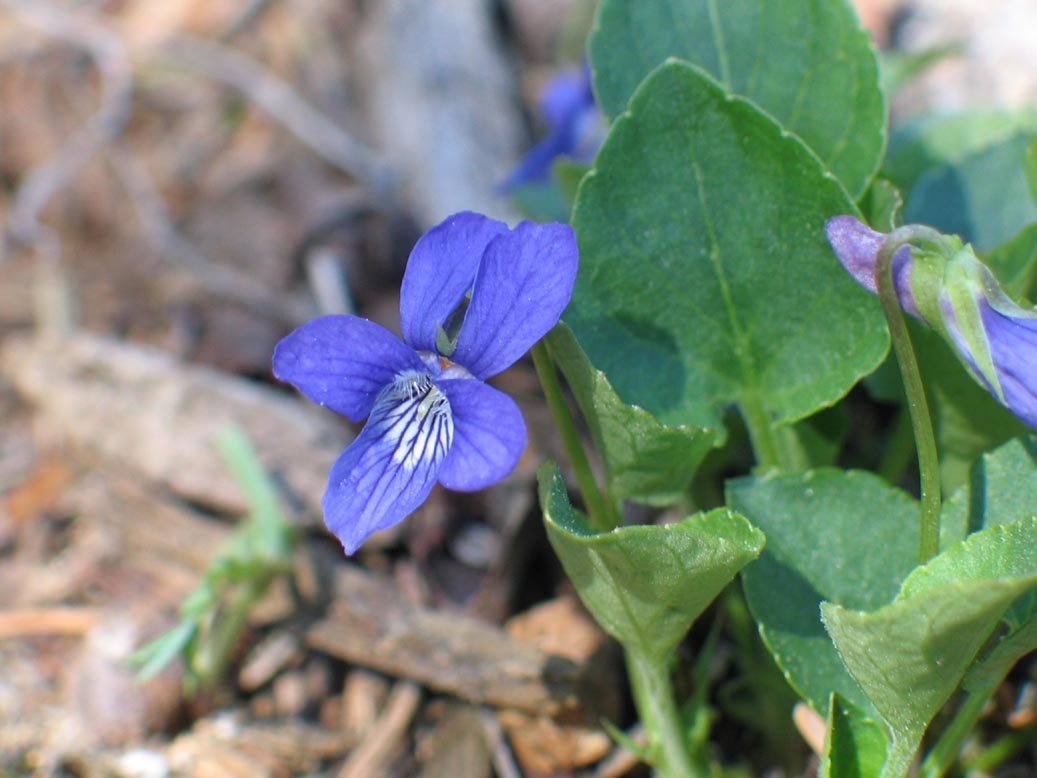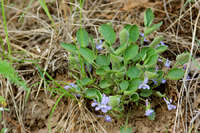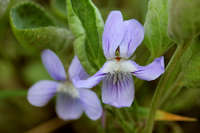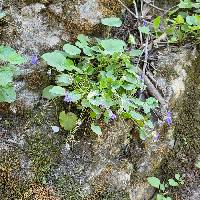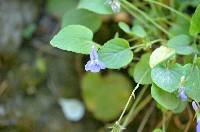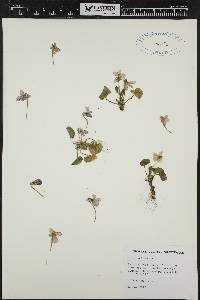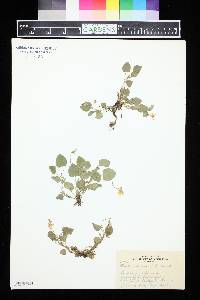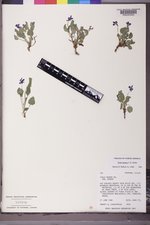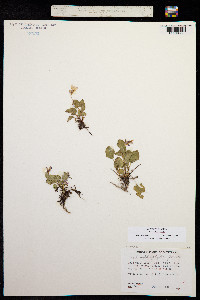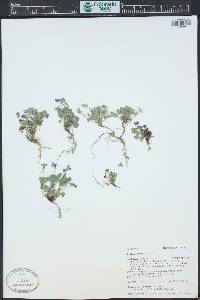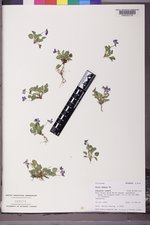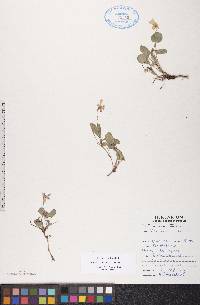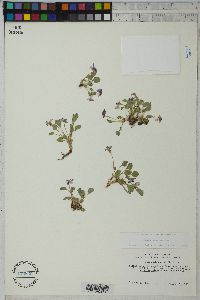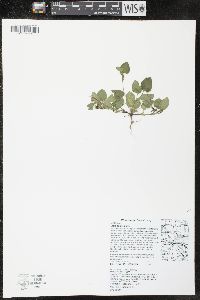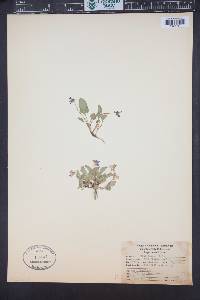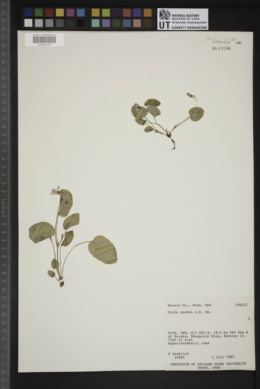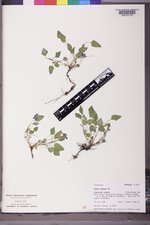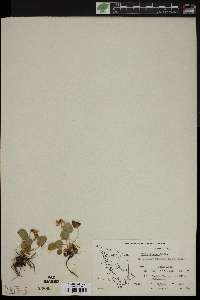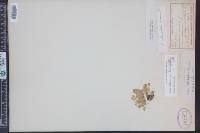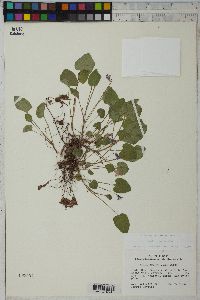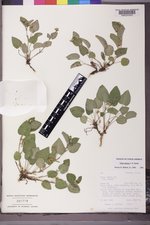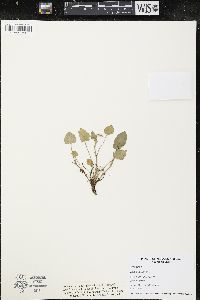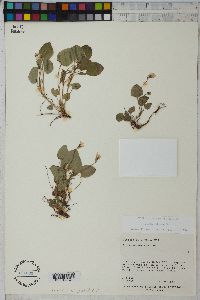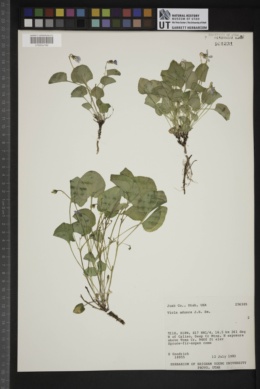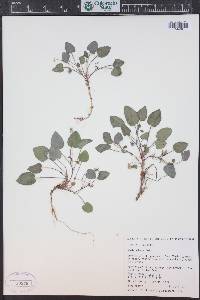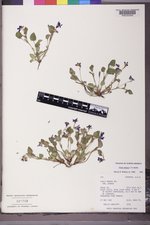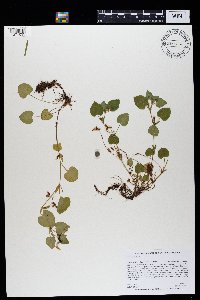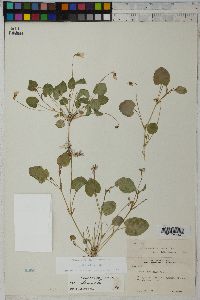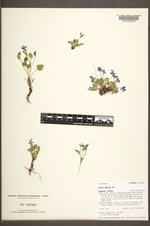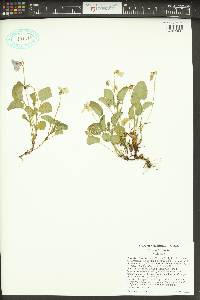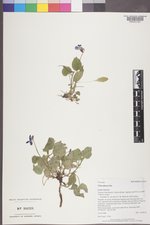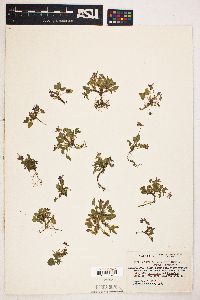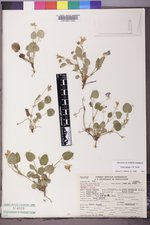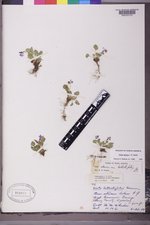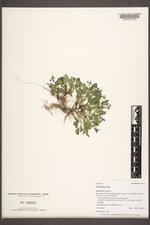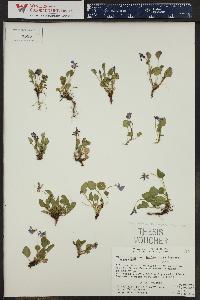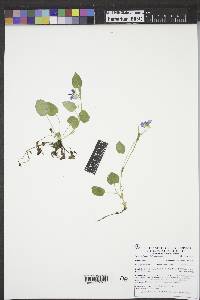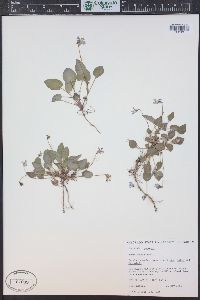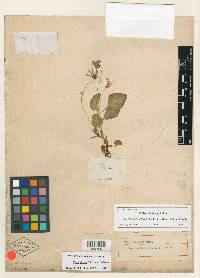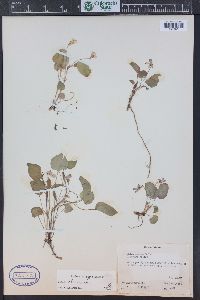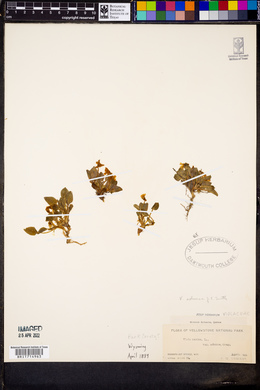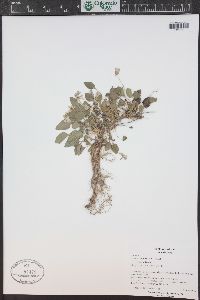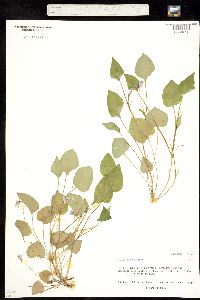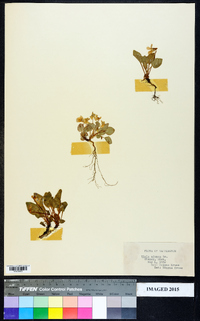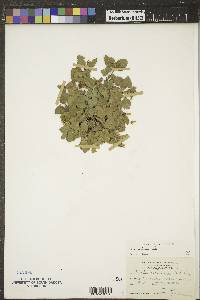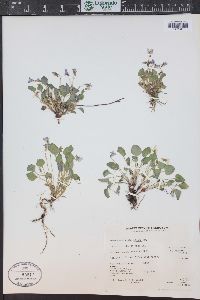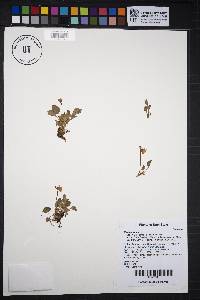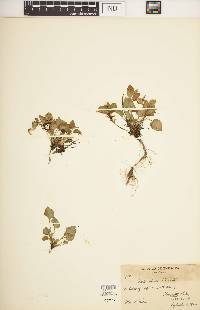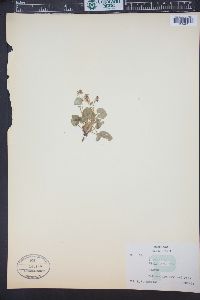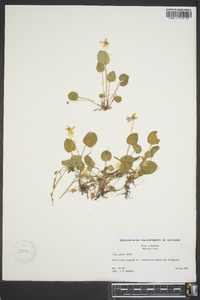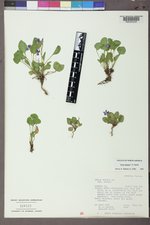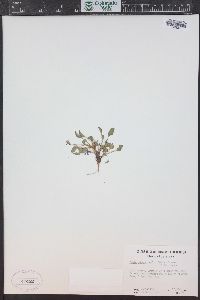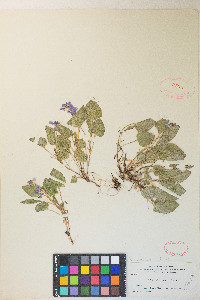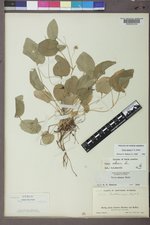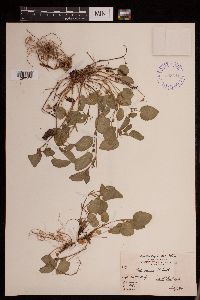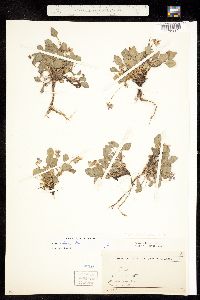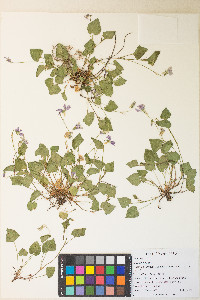Viola adunca
|
|
|
|
Family: Violaceae
Hook-Spur Violet, more...hookedspur violet, blue violet, hook violet
[Viola adunca subsp. typica M.S. Baker, moreViola adunca var. bellidifolia (Greene) Harrington, Viola adunca var. glabra , Viola bellidifolia subsp. valida , Viola clarkiae , Viola longipes , Viola mamillata Greene, Viola minima M. S. Baker] |
Plant: perennial herb; 6-30 cm tall; stems branched, at first short, usually elongating later in season, usually pubescent, clustered on thin much branched rhizomes Leaves: simple, basal and cauline; petioles 5-70 mm long; blades 5-40 mm long, 4-45 mm wide, round-ovate, glabrous to pubescent; margins usually crenate; base truncate to cordate; tip obtuse INFLORESCENCE: axillary; pedicels to 10 cm long Flowers: sepals to 7 mm long; petals pale to deep violet, the lower 3 purple-veined, white-bearded at base, the lateral 2 white bearded, the lowest petal (including spur) 8-16 mm long, the spur elongated, conspicuous, straight, curved, pointed or hooked at tip, 5-12 mm long to 3 mm wide Fruit: FRUITS 6-11 mm long, glabrous; SEEDS ca. 15-20, usually ovoid, with a prominent caruncle Misc: Damp banks, meadow edges in coniferous forests, usually in shade; 2050-2900 m (6700-9500 ft); May-Jul REFERENCES: Little, R. John. Violaceae. 2001. J. Ariz. - Nev. Acad. Sci. Volume 33(1). Perennial herb 2 - 15 cm tall Leaves: both basal and alternate, stalked, dark blue-green, thick, densely short-hairy, mostly non-toothed (sometimes with obscure round teeth), 1 - 3 cm wide, narrow egg-shaped to triangular with flattened base and rounded, but tapered tip. The stipules are green, 1 - 1.5 cm long, lance-shaped to elliptic, and fringed along the upper edges with thread-like segments. Flowers: in upper leaf axils, long-stalked (extending beyond leaves), dark blue or dark purple, about 1.5 - 2 cm long, bilaterally symmetric with two upper petals, two lateral petals, and lower petal with base modified into a relatively long nectar spur. In the summer, very fertile flowers that do not open (cleistogamous) are usually produced on leafy branches. Sepals: five, green, narrowly lance-shaped with ear-like appendages (auricles) at the base. Petals: five, separate, all differently shaped, dark blue or dark purple. The two lateral petals have a beard of hairs near the base, and the lowest petal is prolonged at its base into a 4 - 6 mm long spur. Stamens: five, separate, but very tightly arranged so anthers touch as they surround ovary. The filaments are very short, and the lower two stamens have spur-like nectaries on their backs that extend into the spur of the lower petal. Pistil: with a single-chambered, superior ovary; and a single slender, somewhat hairy-tipped style that curves slightly below the stigma. Fruit: a many-seeded, 4 - 5 mm long, ellipsoid capsule that opens lengthwise from top. The seeds are dark brown and have a large amount of oily endosperm, and often an appendage (aril). Stems: several, tufted (from a rhizome), ascending or spreading, densely short-hairy (sometimes hairless), producing both leaves and flowers. Similar species: Viola adunca is very similar to V. labradorica, but that species has flowers that are pale or light blue, and more broad, lighter green, thin textured, mostly hairless leaves. Also very similar is V. rostrata, but that species has pale purple flowers with only a central dark area, no beards inside the lateral petals, and the leaves are mostly hairless. Flowering: May Habitat and ecology: Incredibly rare, only collected once from an unknown locale in Illinois, which is well south of the reported range for the species. Within its range, this species is expected in gravely or sandy soils. Notes: This species hybridizes with V. rostrata and V. labradorica. The single Chicago Region collection from Illinois is quite perplexing since this species does not range south of central Michigan to the east, and ends just north of the Chicago Region counties in Wisconsin. Etymology: Viola is the classical name for the genus. Adunca means "bent towards or inwards, hooked". Author: The Field Museum Duration: Perennial Nativity: Native Lifeform: Forb/Herb General: Perennial, low-growing herb, to 30 cm tall, stems branching, herbage pubescent, arising in clusters from branching rhizomes, stipules sharply serrate or lacinate. Leaves: Round-ovate, simple, basal, and cauline, with crenate margins, tip obtuse, base cordate to truncate, leaves to 4 cm long, borne on petioles to 7 cm long. Flowers: Blue to violet, the lower 3 with conspicuous longitudinal purple veins, white a tuft of white hairs at the base of the petals, with the bottom petal bearing an elongated spur, spur cylindric, half as long or as long as the petal blade, often hooked, flowers axillary or borne on pedicels to 10 cm long. Fruits: Glabrous fruits to 11 mm long. Seeds ovoid, many, with a prominent caruncle. Ecology: Found in damp soils on stream banks, and wet meadows in coniferous forests, from 6,500-9,500 ft (1981-2896 m); flowering May-July. Notes: A pretty purple violet, low growing, with deep green, pubescent leaves. Synonyms: Many, see Tropicos Editor: SBuckley 2010 Tufted on short or elongate rhizomes, at first anthesis erect, 2-8 cm, and nearly acaulescent, later to 15 cm and more spreading or prostrate, with evidently leafy stems; lvs darker green arid thicker than in no. 24 [Viola conspersa Rchb.], ovate to suborbicular, obtuse, crenulate, subtruncate to subcordate at base, mostly 1-2.5(-3) cm wide; stipules lance-linear, with fimbriate-incised teeth above the middle; peduncles elongate; sep narrowly lanceolate, not ciliate; pet violet, the lateral ones bearded; spur 4-6 mm, straight and blunt, or often tapering to a short, incurved point; style slender, bent at the tip; frs 4-5 mm, ellipsoid; seeds dark brown; 2n=20, 40. Sandy or gravelly, moist or sometimes dry soil; Greenl. and Lab. to Alas., s. to N.Y., Mich., Minn., and Calif. May-July. The widespread and highly variable var. adunca is ±puberulent. (V. arenaria; V. subvestita) Var. glabra Brainerd, more boreal or in our range more alpine, is essentially glabrous Gleason, Henry A. & Cronquist, Arthur J. 1991. Manual of vascular plants of northeastern United States and adjacent Canada. lxxv + 910 pp. ©The New York Botanical Garden. All rights reserved. Used by permission. |

